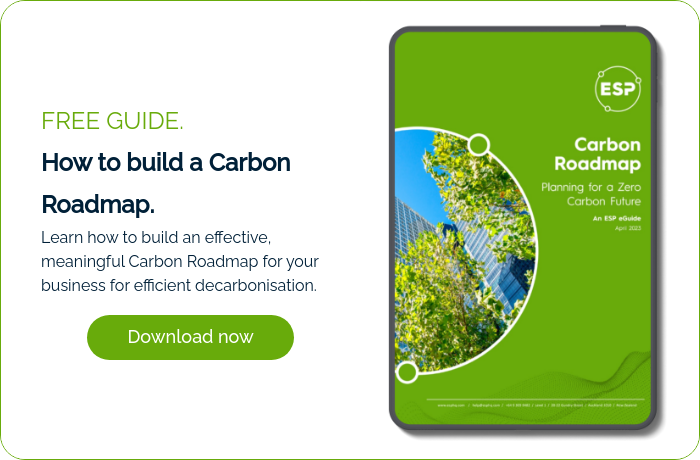
carbon footprint, carbon emissions
Tackling Scope 3: Supplier Engagement
The crucial role of supplier engagement in Scope 3 reporting
By now, you'll be fully aware that sustainability is no longer just a buzzword; it's become an essential imperative for organisations worldwide. This is especially true for sustainability managers, since their role extends beyond the boundaries of immediate operations. You now must consider the broader impact of your entire value chain. Central to this expanded responsibility is the concept of Scope 3 reporting, a vital component of comprehensive carbon reporting that delves into the intricate web of supply chain emissions.
Many businesses are carbon reporting entities, required by law to fully report their carbon emissions, including Scope 3. As a flow-on effect, other businesses that supply them or are supplied by them will be expected to provide their own carbon emissions. At the heart of this expanded responsibility is reporting. Scope 3 reporting delves into the network of supply chain emissions, shedding light on the intricacies that weave through your organisation's sustainability fabric.
While Scope 1 and Scope 2 emissions account for direct and indirect greenhouse gas emissions associated with your organisation, it's Scope 3 emissions that hold the key to a more accurate and holistic understanding of your environmental footprint. Scope 3 emissions, originating from activities outside your direct control, have the potential to represent the lion's share of your overall carbon footprint.
So let's take a closer look at Scope 3 reporting and the significance of supplier engagement in achieving precise and comprehensive carbon reporting.
Navigating the challenges of supplier emissions reporting
Understanding and managing the environmental impact of your organisation's supply chain can be complex. While Scope 3 emissions offer valuable insights into the full extent of your carbon footprint, obtaining accurate data from suppliers can be challenging.
The main issue is that suppliers may not have the capability or resources to report their emissions directly. Unlike Scope 1 and Scope 2 emissions, Scope 3 emissions involve a diverse array of activities spread across numerous suppliers. Each supplier operates independently, with unique processes, reporting practices, and environmental data management systems. In a nutshell - uniform and consistent emissions reporting is a tough ask. Here's why:
- Limited data availability. While some suppliers have begun their sustainability journey and have relevant data at hand, others have not begun to measure their environmental impact or lack the necessary tools to do so accurately.
- Inconsistent reporting methodologies. This can lead to discrepancies in the information provided, making it challenging to collate and compare data effectively.
- Resource constraints. Reporting Scope 3 requires significant resource from large businesses; they may require dedicated sustainability managers or a full sustainability team to ensure data collection and accuracy. For smaller suppliers, dedicating resources to emissions reporting and sustainability initiatives might not be a priority due to limited budgets or expertise, creating issues for the businesses they supply due to the subsequent lack of Scope 3 data.
- Complex supply chain networks. Large organisations often have intricate and extensive supply chain networks involving multiple tiers of suppliers. Tracking emissions data across such complex networks becomes increasingly challenging as the scope widens and data sources become more dispersed.
- Data security and confidentiality. Suppliers might be concerned about sharing sensitive data related to their operations and processes, especially if they perceive it as a potential risk to their competitiveness or intellectual property.
The good news is that achieving a comprehensive understanding of your supply chain emissions isn't as difficult as you might think. Let's take a closer look at some strategies for effective supplier engagement, including how you can leverage technology to drive positive change throughout your supply chain.
Smart Forms and Spend-based Modules key to empowering supplier engagement
Addressing the challenges of supplier emissions reporting requires an innovative approach that streamlines data collection, enhances transparency, and fosters collaboration. ESP's cutting-edge software offers two powerful solutions - Smart Forms, available through our enterprise carbon accounting software, and our dedicated Spend-based Emissions Module - specifically designed to simplify supplier engagement.
Smart Forms: Simplifying data collection
Our enterprise carbon accounting platform, CSR, includes a feature designed to assist with Scope 3 data collection: Smart Forms.
Smart Forms are user-friendly, web-based forms that can be easily customised and sent to suppliers to gather essential carbon data. They make the data collection process seamless and straightforward, encouraging suppliers to provide accurate emissions information efficiently. Smart Forms are tailored to capture the specific emissions data required for comprehensive Scope 3 reporting, ensuring consistency and completeness across your supply chain.
With Smart Forms, suppliers no longer need to navigate complex reporting methodologies; they can submit their emissions data with ease, providing you with a consolidated and up-to-date view of your supply chain emissions. In addition, Smart Forms provide a consistency of data format across your entire supply chain, ensuring that you get the data you need in the form that you need it to effectively and easily integrate it into your broader carbon reporting system.
The Spend-based Module: Unveiling deeper insights
This is a new, innovative standalone software product built on our CarbonHUB platform, designed to extract, categorise, analyse, and manage supplier carbon data using a spend-based methodology. By leveraging financial data, such as invoices and spend records, this module allows you to quickly gather Scope 3 data without the need to demand activity- or use-based emissions from suppliers. All you need is an invoice – the module handles collection and analysis and it makes categorisation and emission factor application easy with a dedicated wizard and automation.
By utilising financial spend data, you can estimate the carbon footprint associated with your purchases from suppliers, gaining valuable insights into the environmental impact of your procurement decisions. This approach not only fills data gaps but also strengthens your capacity to make informed, sustainability-driven procurement choices.
The combination of Smart Forms and the Spend-based Module redefines the way sustainability managers engage with suppliers, transforming the supply chain into a powerful force for positive change.
Driving sustainable success through collaborative supplier engagement
As you can see, the challenges of Scope 3 reporting can be overcome through a strategic combination of innovative technology and collaborative efforts.
ESP's Smart Forms and the Spend-based Module are a pair of solutions that enable you to gather accurate emissions data, foster transparency, and elevate supplier engagement. By leveraging these purpose-built software tools, you can streamline data collection, analyse supply chain emissions more comprehensively, and identify impactful opportunities for sustainability improvements.
Through open communication, shared goals, and data-driven decision-making, supplier engagement becomes a collaborative endeavour, benefiting both your organisation and your suppliers.
Keen to find out more? Book a meeting with our team and we'll show you our tech in action

